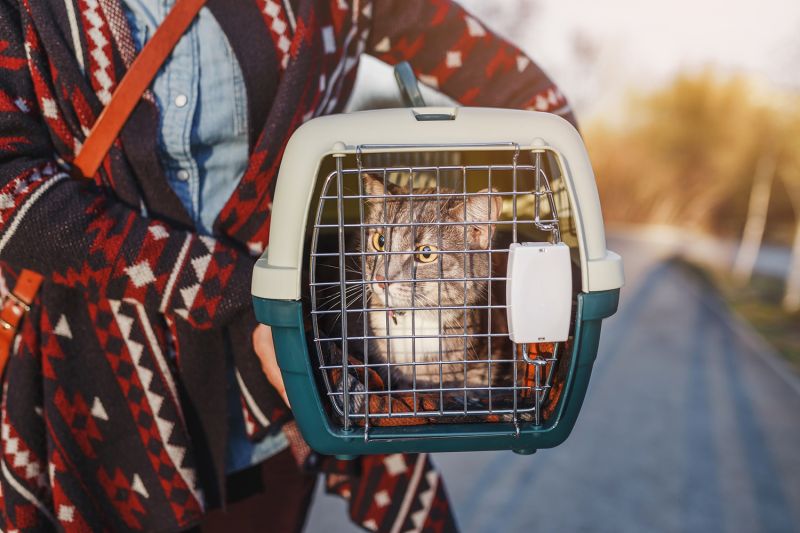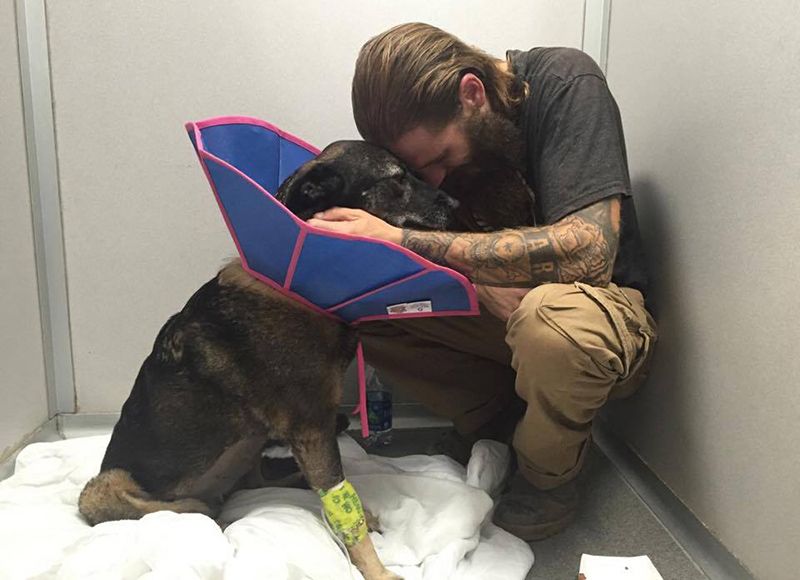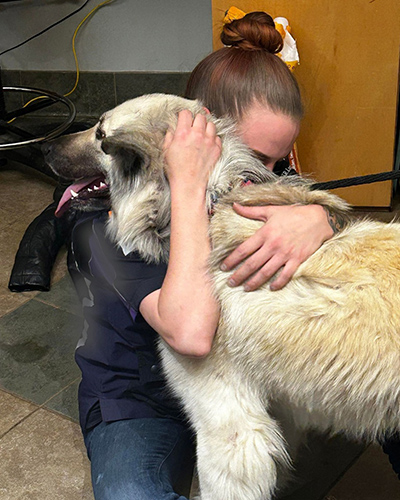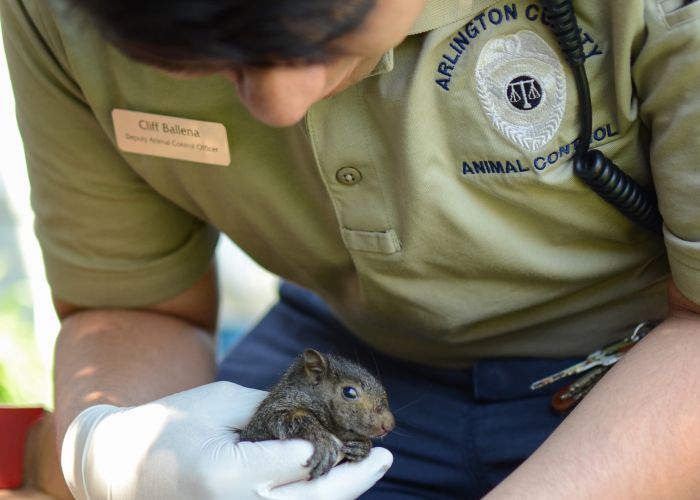A better approach to pet surrenders
Many sheltering professionals are reexamining how they view pet relinquishment, but progress is still needed within the field

Little was known about the tan dog when a community member first brought her to McKamey Animal Center in Chattanooga, Tennessee, after finding her wandering around outside in January. But a note shelter staff found attached to the dog’s collar quickly provided insight into her backstory.
It read: “My name is Lilo. Please love me. My mom can’t keep me and is homeless with 2 kids. She tried her best but can’t get help. I cost too much for her. She really loves me & im a great dog & love to be loved on. Please don’t abuse me.”

The shelter posted Lilo’s story on Facebook along with a message to the owner: We can help you get the resources you need to keep Lilo. Within 24 hours, the owner was found and the two were reunited at the shelter, where Lilo is staying while staff help the family find permanent housing. The story of their reunion quickly gained widespread attention, appearing in The Washington Post, Good Morning America and Today.
On social media, people praised the shelter’s approach and empathized with the owner. “This is one of the most compassionate things I have read,” one person commented. “I know her family must be devastated to have had to make that decision,” said another.
Inga Fricke, executive director of McKamey Animal Center, says staff were surprised when the story became national news. “We just did what we do every day and tried to connect with her owner and let her owner know there may be some options,” she says, noting the organization’s mission of “Saving animals. Helping people.”
Fricke’s organization isn’t alone: Many shelters have embraced this community-centric approach, and with it, have changed how they view people who leave behind or surrender pets.
Across ‘enemy’ lines
When Lindsay Hamrick, HSUS director of shelter outreach and engagement, first entered the sheltering field as a volunteer in the late 1990s, she says it was common for shelter staff to be judgmental toward people relinquishing pets. The perception was these pet owners “weren’t bonded to their animals, that the reasons they were bringing animals in weren’t good enough,” she says.
Fricke saw similar perceptions when she began volunteering at shelters in 1994. “I think overwhelmingly there was a sense that pets are forever and anyone who does not keep their pet, regardless of circumstances, probably doesn’t care.”
Pet relinquishment was largely seen as a problem with individual pet owners, says Amanda Arrington, HSUS vice president of access to care. “If someone was struggling, it was believed that that person made bad decisions, that that person was just a bad pet owner.”
Around this time, an estimated 5.7 million animals were being euthanized in U.S. shelters—a burden placed on shelter staff. Many surrendered animals were also litters of puppies and kittens, says Hamrick, adding to an “us against the irresponsible public” mindset among shelter staff.
Natalie DiGiacomo, director of community outreach at Bucks County SPCA in Pennsylvania, became accustomed to this way of thinking when she started volunteering at shelters in 1991. So when she decided to study the perspective of people relinquishing pets as part of her master’s degree in 1997, it felt like she was “crossing enemy lines.” Over three months, she interviewed 38 pet owners surrendering pets to a Boston-area shelter.
“What I found was the situation was so much more complicated, that once given the opportunity to talk without judgment, these folks were not at all what I had built up in my mind,” she says.
“What I found was the situation was so much more complicated, that once given the opportunity to talk without judgment, these folks were not at all what I had built up in my mind.”
—Natalie DiGiacomo, Bucks County SPCA
Every pet owner she interviewed struggled with the decision to relinquish their pet, and many held off doing so until the situation became so untenable it outweighed the owners’ attachment to their animals. The decision often cumulated over months or years before the owner arrived at the shelter. The research served as a turning point in DiGiacomo’s career. “It forced me to get rid of my judgment,” she says.
Published in Anthrozoös in 1998, the study identified three broad factors contributing to relinquishment:
- acquisition problems, such as people who took in pets for family members or rescued animals found living outdoors;
- internal pressures, such as financial issues or health problems; and
- external pressures, including changes in rental policies that previously allowed pets.
Today, people still relinquish their pets for many of the same reasons. Research shows that housing issues, financial constraints, lack of access to care and behavioral issues are among the top reasons. Pet relinquishment is a complex decision; people of all income brackets and communities—whether in rural towns or large cities—love their pets, Hamrick says. But their ability to access resources that can help prevent relinquishment vary widely.
The need for pet assistance resources has become starkly evident in the wake of the COVID-19 pandemic. Rising eviction rates in some areas, soaring rents, a shortage of pet-inclusive housing, and increasing costs for food and other goods have hit lower income pet owners the hardest. A February 2023 survey found that 24% of pet owners considered rehoming or surrendering their pet in the past 12 months for financial reasons.
Some shelters and rescues have seen an increase in owner surrenders recently. But a data analysis by Shelter Animals Count found that national owner relinquishment rates have remained consistent from 2019 through 2022. The increase in support services at shelters and rescues over the past few years could explain why surrender rates haven’t changed nationally despite increased socioeconomic strains impacting pet owners, says Arrington.

Addressing root causes
Even before the pandemic, the sheltering field had changed greatly since Hamrick, Fricke and DiGiacomo began volunteering in the '90s. With declining intake and euthanasia numbers, more shelters have been able to spearhead interventions—such as safety net programs that provide temporary foster care or boarding options for pets, low-cost veterinary services and assistance finding pet-inclusive housing—to address the root causes of relinquishment.
Since the HSUS Pets for Life program launched in 2011, Arrington has seen a steady increase in shelters interested in community outreach work. Such programs not only empower shelter staff to offer alternatives to relinquishment in many cases but also lead them to interact with the public on a deeper level, says Sloane Hawes, assistant director of research at the Institute for Human-Animal Connection. “We’re actually taking the time to connect with [pet owners] and just understand their story.”
In Chattanooga, where an estimated 14,300 dogs and cats live in homes at or below the poverty line, the McKamey Animal Center’s Pets for Life program helps keep pets in their homes. The recent exposure from Lilo’s story gave the shelter the opportunity to create the MAC Cares Fund, which provides financial support to pet owners in need. The shelter was also invited to join a coalition of local organizations working to address human homelessness.
In addition to implementing pet owner support programs, shelters can also make internal changes to address issues related to pet relinquishment. Having a staff that reflect the community they’re serving can help people feel more comfortable reaching out for assistance, Hawes says. Shelter leaders should also take time to understand the experiences of their front-line staff and help them remember the big picture when they get discouraged, Hamrick adds.
Shelters that invest in programs to prevent relinquishment may see a positive impact on their finances, as well: It often costs less to implement interventions to keep pets in loving homes than to house and care for relinquished animals.
Compassion in action
While there has been progress, negative feelings toward people giving up their pets still exist in the field.
It’s understandable that staff can become jaded after being exposed to heartbreaking cases every day, says Hamrick. An overcapacity of animals, decreased adoptions, staff and volunteer shortages, and other day-to-day challenges can make it even more dispiriting when pet owners come to relinquish animals. The negativity bias (where people place more emphasis on negative experiences than positive ones) can also impact staffs’ perceptions after a difficult experience with someone relinquishing a pet.
“Judging makes us feel good in the moment because it’s a release of the anger and the anguish that we feel,” Fricke adds.

In our modern era, feelings of judgment can seep out not only in interactions with the public but also through organizations’ social media pages, in posts about animals who were “dumped” or dropped off by owners who “didn’t even try” interventions to keep the pet in the home. If organizations project an outwardly judgmental attitude, pet owners are unlikely to reach out for help.
“Interventions that reduce pet surrenders—like behavior support, like medical care for their pets, like pet food pantries, like landlord negotiations to try and keep a pet in a house or apartment—none of that can happen if the public doesn’t feel comfortable calling their local shelter as a resource,” Hamrick says.
To facilitate healthier, more effective interactions between their staff and the public, many shelters are investing in programs and policies that support the emotional health of staff and combat compassion fatigue. Some are providing training on trauma-informed care and social work principles, helping their staff gain a more holistic view of the challenges that can force people to give up their pets.
“No one is happy about separations of people from their pets,” says Fricke, “but I think there’s a lot more understanding and forgiveness and a sense that judging people doesn’t help solve any of the problems.”
Open conversations
Relinquishing a pet is an “absolutely traumatic experience,” says Arrington, one that can be even more acute if the owners are also struggling with a major life change, such as a serious illness or job loss. A 2014 study found that the vast majority of owners relinquishing their dogs at shelters in New York City and Washington, D.C., underwent recent changes in the home that contributed to relinquishment.
How people process these emotions can vary: Some people’s grief is clear, while others seem stoic. “Regardless of how they look the day they surrender a pet, many of them are getting back in their cars and crying, and they have been struggling with that decision for a long time,” says Hamrick.
“Everyone’s going to process that experience differently,” says Hawes. “We shouldn’t judge people in particular who come off [as less caring] or who appear to be quite shut off. … That in and of itself is a trauma response, and it doesn’t mean that that person loves their animal any less.”
As part of her master’s degree in social work, Hawes counseled pet owners seeking to relinquish pets to a Denver-area shelter in 2016. When she started, staff would talk with people relinquishing pets in the lobby, in front of other members of the public. Hawes requested a private cubicle where she could bring people to talk. Once given a separate space, Hawes found that owners shared a lot more information about the challenges they were facing.
“We shouldn’t judge people in particular who come off [as less caring] or who appear to be quite shut off. … That in and of itself is a trauma response, and it doesn’t mean that that person loves their animal any less.”
—Sloane Hawes, Institute for Human-Animal Connection
After talking with pet owners, staff may uncover problems the owner previously didn’t mention—along with solutions to turn what would have been a relinquishment into an opportunity to keep a family together. A 2015 study at a Los Angeles shelter found that 80% of people relinquishing dogs weren’t aware of available services in their area. Most of the reasons for relinquishment were likely solvable with interventions, the authors concluded.
At the same time, Arrington notes that staff shouldn’t force pet owners to talk if they seem uncomfortable with questions. “It is hard when you are in that moment of crisis to open yourself up to others and to be vulnerable in sharing your lived experience and giving that emotional labor,” she says.
Hawes agrees: “Rule number one of trauma-informed care is choice, like allowing people to choose how and where and what they share.”
When shelter staff encounter scenarios where relinquishment is truly the best option, Arrington suggests assuring the owners that they are not being judged and acknowledging that they care for their animal. “Let them know that their tough decision is a decision of love,” she says.
Moving forward with optimism

Changes in how organizations approach pet relinquishment represent just one aspect of a larger shift within the sheltering field—away from solely focusing on animals and instead embracing both pets and the people who love those pets. “The next phase of our work is figuring out how we are active participants in issues that are traditionally beyond animal welfare,” says Arrington.
“I really see a prime opportunity for animal welfare organizations to engage in social justice work” at an individual, community and policy level to address the reasons animals are brought to their doors, says Hawes.
McKamey Animal Center saw firsthand how intertwined animal welfare is with other social issues while trying to help Lilo’s family find permanent housing. “We have gotten a serious reality check over the past few weeks about what a complex challenge it is to be homeless in our community. … Believe it or not, it takes an average of 585 days for a homeless person to be successfully rehoused in Hamilton County,” the organization posted on Facebook in March. “We have been exposed to the true reality of homelessness and how nearly impossible it can be to break out of its grip—with or without pets.”
As of press time, shelter staff are still working to find Lilo’s family permanent housing, and they are continuing to collaborate with organizations focused on homelessness to help more pet owners in the community. Addressing pet relinquishment, and the broader socioeconomic issues tied to it, is incredibly nuanced, and the solutions won’t always be simple, says Arrington. But the sheltering field is already entering this next phase of work and seeing positive change.
On the future direction of the sheltering field, Hawes says she’s “optimistic—and we’ve got work to do.”







